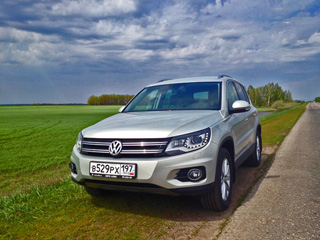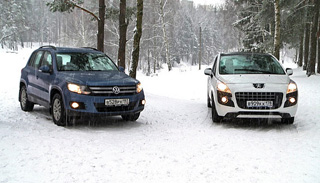Volkswagen Tiguan test drive since 2011 crossover
Mazda CX-5 VS Volkswagen Tiguan. The struggle of technology
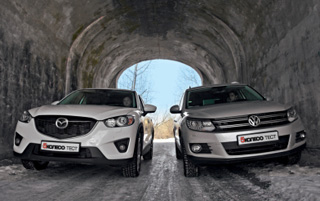 The Japanese claim that their new Mazda CX-5 is a fundamentally different car. That is, not similar to anything previously produced by this company.
The Japanese claim that their new Mazda CX-5 is a fundamentally different car. That is, not similar to anything previously produced by this company. Mazda SC-5. Price: from 911 000 p. On sale: since 2012
VW Tiguan. Price: from 896,000 p. On sale: since 2011
Oleg Kalaushin, 42 years old, automobile journalist, driving experience 23 years, personal car - Renault.
They called this SkyActiv technology improvement of running qualities not to the detriment of fuel efficiency. Well, the more interesting it is to compare the novelty with a machine created according to traditional technologies, namely with VW Tiguan.
They would never say that Mazda CX-5 is easier than VW Tiguan. In offhand, the Japanese seems clearly worse and heavier than his German opponent. CX-5 is more thicker, and more solid. But it is worth looking into the technical characteristics, as you immediately understand how deceptive appearance can be. The difference in the equipped mass between these two cars is almost 200 kg. That is, a more subtle -looking Tiguan turned out to be much heavier. Here you have the first argument in favor of the new technology that the Japanese boast so. By the way, it is worth noting that the lightness of the body did not go to the expense of its strength, moreover, due to the use of new materials and adhesive compounds, it has become even stronger. However, we will continue.
Yes, Tiguan is heavier than its counterpart and less. But does this mean that the high -tech Mazda is much more spacious? Moreover, we were convinced how much the appearance could be deceiving. Well, since both cars are universals, let's look at the trunk. At first glance, Mazda has a large volume, but we take TTX and a miracle in your hands! Tiguan is larger than the trunk. But how can it be, because visually it is more for Mazda! The secret lies in the possibility of transformation. In the difference from CC-5, Tiguan can be increased by the cargo volume, not only folding the backs, but also pushing the seats forward. Of course, in this case, the rear passengers will not be very comfortable, but in crowded, but not offense. In Mazda, when transporting a bulky cargo, passengers will have to be planted. But in order to lay out the seats, it is not necessary to crawl along the cabin in search of the corresponding loops or handles. Mazda is much simpler, there are three handles in the trunk, pulling the folding mechanism for which we drive, while the seat goes down and forward, and the back falls on its level. This can be done with both left and right seats, and with the central block. The latter is provided to facilitate the transportation of long -termers, whether it be skis or snowboarding. But for this indicator, Tiguan still went further. To transport long -breeders, not only the central part of the seat is folded in it, but also the front back. That is, the load can be placed from the instrument panel to the fifth door, which is 2.5 meters, no less.
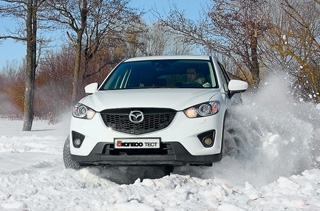
And what about passengers? It seems to us that passengers with great comfort will transfer the long road to Tiguan. Firstly, his back is adjusted along the angle of inclination, we did not find such a function in the CX-5, and secondly, two air ducts are approached by the second row passengers, which is also not in Mazda. However, for the sake of objectivity, we note that there are plenty of places for both the legs in the first and second cars. Yes, and over his head is enough. By the way, transplanting from one car to another, one cannot but notice that the second row in Mazda is below the front ones, and in Tiguan the other way around. The latter is due to the exterior of cars. Mazda has a more rolling roof, and the car itself is lower. By the way, height is the only overall indicator by which Tiguan surpassed Mazda.
We continue to move around the cabin. We don’t know how it happened, but the CX-5 instrument panel almost completely copies the BMW instrument panel. It is impossible to blame Japanese designers of one hundred percent plagiarism, but it turned out very similar. Even the instrument shield became somehow flat. And there is no need to talk about the central console.
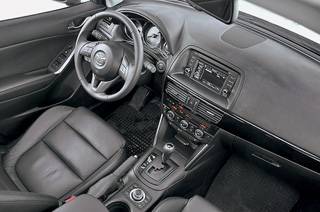
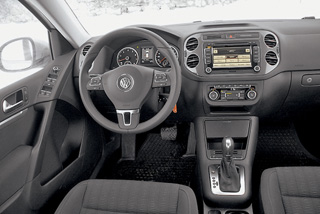
The architecture of the famous Bavarz is traced, as they say, from and to. But we have what we have, and I must say, such an interior looks very harmonious in this car. But the ergonomics disappointed. So, for example, the front passenger is very inconvenient to close the door, the handle is located very far. Or it is not clear why the hatch opens in automatic mode, and you need to close it with holding the key from beginning to end.
In this regard, Tiguan is much more practical. Everything is as it should, and where necessary. The only thing the driver can complain about while driving this car is an insufficient area of \u200b\u200bexternal mirrors. They are painfully slurred compared to CX-5. When maneuvering reversing, the rear view camera helps out very much, but its location leaves much to be desired. The fact is that it is located at the lowest point of the fifth door, and therefore the vertical review is insufficient. The Mazda camera is much higher, and therefore the review is much better. Since we talked about cameras, we also note where the image is displayed from them. In the first and second car, these are quite large and active TFT displays, but Tiguan can also be duplicated on a small display on the instrument panel. In particular, you can make instructions of the navigation system there, while the main display will be involved in something else.
For the test, we took cars with automatic 6-speed boxes and 2.0-liter engines. The high -tech motor of Mazda was able to squeeze out 150 horses, no less technological engine Tiguan could boast of 170 horses. Now, looking at the table of technical characteristics, you understand that this difference is in horses, although it is great, but insignificant, because the dynamic characteristics of cars are actually identical. But the sensations of Tiguan were still much more agile. And first of all, due to the fact that the maximum torque is available here at 1700 rpm, while the CC-5 had to twist as much as 4000.
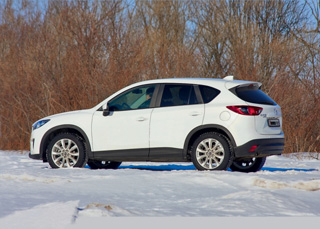
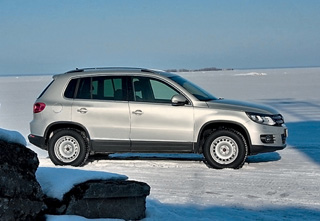
Tiguan more lively responded to the acts of the accelerator pedal, stripped the programs much more faster, and in general, in his actions there was more life. Even in corners, due to a tighter suspension, it practically did not roll. Mazda, despite similar characteristics, was not so active. She generally became some other. This is no longer that buzzing, throwing its tail in corners and shakes the whole soul of a lighter on bad roads. It has more degree and predictability. She became the personification of comfort and prestige, and at the same time, if you ask it very much, it can become a little cheeky, just a little. Yes, on the straight lines, due to the literally pouring the heaviness of the steering wheel, it is a sample of stability, but it is worth laying a turn, as you know that there can be no one hundred percent compromise between comfort and controllability.
Speaking of crossovers, one cannot fail to mention their possibilities to overcome off -road. It just so happened that neither in Mazda nor in Tiguan there are no locks that the driver could control. In this connection, everything that the car can on the road is laid in it during design. And, alas, neither the CX-5, nor Tiguan (in this case, the machine was equipped with OFF-Road package) could not boast of outstanding characteristics. Systems that imitate the operation of blocking, that the first, that the second did not work very adequately, and therefore even moving along shallow snow could end for each of them with a captive. As soon as one of the wheels was losing the clutch, it began to rotate helplessly, digging deeper. And it is likely to give a little more to the gas, and the moment will be redistributed, but I really did not want to do this: you perfectly understand that a couple more dozens of revolutions, and the car will fall on the belly. And here no redistribution will help. So, by the way, happened to Tiguan.
But along the rolled and rather hilly paths, both jumped quite briskly clearance of 200 mm allowed to do this without problems. But still, geometric patency due to the smaller wheelbase was slightly better for Tiguan.
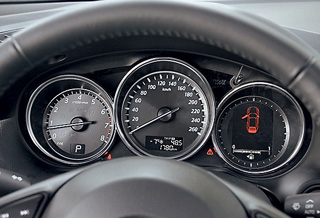
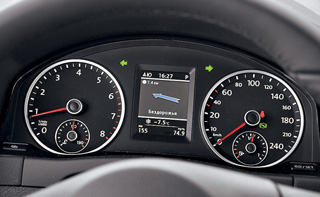
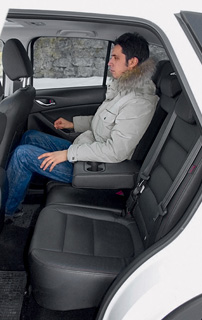
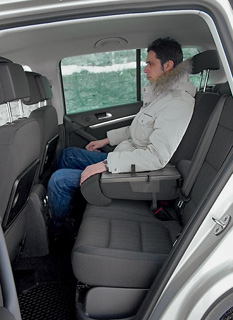
Mazda CX-5 from 911 000 p.
Driving
Despite the actual weight, the car seems heavier than it really is. The sluggishness of the automatic transmission is affected.
Salon
The driver and the front passenger do not experience discomfort, but the back of the second row is too vertical.
Comfort
Noise insulation and suspension at the level.
Safety
6 pillows, ESP, ABS.
Price
At the level of competitors.
VW Tiguan from 896 000 p.
Driving
The dynamics is very good, there is no problem and handling.
Salon
It is equally convenient for both the driver and passengers. It is possible to increase the luggage compartment due to the longitudinal adjustment of the second row of seats.
Comfort
The suspension is harsh, but this does not particularly affect comfort.
Safety
6 pillows, ESP, ABS.
Price
Competitive.
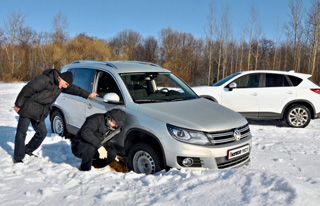
It seems to be a shallow fossa, but without outside help can no longer get out
Our verdict
Undoubtedly, the Mazda CX-5 is a modern and technological car, but we do not undertake to say with complete confidence that the technologies that found in it put this model on the head above competitors. Volkswagen Tiguan was not much less technological, and in the aggregate of qualities it is practically not inferior to a younger op-ponent. Unless he pumped up with weight, but he will have more fuel consumption. So he has more powerful engine.
Source: Magazine 5 wheel [April 2012]

.jpg)
.jpg)
.jpg)
.jpg)
.jpg)






